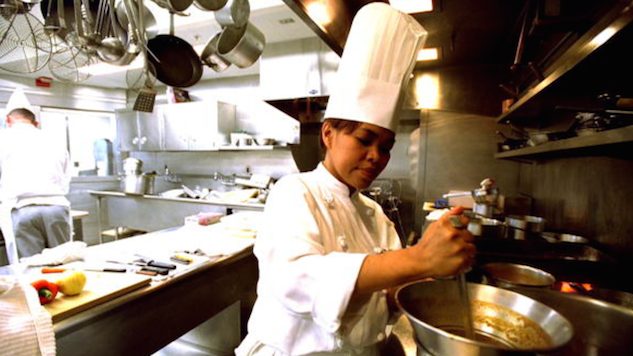The Soul of the White House: Adrian Miller’s The President’s Kitchen Cabinet
Photo by Tina Hager/WireImage/Getty Food Features Adrian Miller
Donald Trump had been in the White House for exactly one month when Adrian Miller’s new book, The President’s Kitchen Cabinet: The Story of the African-Americans Who Have Fed Our First Families, from the Washingtons to the Obamas, hit bookstore shelves on President’s Day. But three days later, when the James Beard award-winning Miller appeared on stage at New York City’s Schomburg Center for Research in Black Culture to talk about the book with fellow food scholar Tonya Hopkins, audience members, including this writer, could have cared less about the new president. We wanted, it seemed, to stay in the warm afterglow of President Obama and First Lady Michelle Obama, the First Couple who could move with authenticity and ease between casual Ben’s Chili Bowl, where no hot dog costs more than $5.95 (unless you add cheese), and Michelin-starred Blue Hill, where diners can choose between the $88 and $98 per person tasting menus and cell phones aren’t allowed at tables.
The auditorium full of food lovers wouldn’t entertain any thoughts of the current occupant of the White House, who is reputed, in the words of New York Times reporter Ashley Parker, to be a “junk food aficionado” with aspirations of becoming the nation’s “fast food president.” From the campaign trail, he beamed out photos of himself enjoying a bucket of KFC fried chicken (served with a generous side of mashed potatoes and gravy, of course) and tucking into a taco bowl on Cinco de Mayo, proclaiming, “I love Hispanics!”
Once in the White House, it was reported that kitchen staff stocked the larder with the new president’s favorite snacks, including Lay’s potato chips, and, as is customary, indulged Trump’s tastes even at formal state meals, ensuring, for example, his favorite iceberg lettuce wedge salad with blue cheese was on the menu at a lunch with the British prime minister, and “the most delicious chocolate cake” was served at a “Winter White House” dinner as he decided to bomb Syria. “Mr. Trump’s presidential campaign is improvised, undisciplined, rushed and self-indulgent. And so is his diet,” wrote Parker before Trump took possession of 1600 Pennsylvania Avenue, adding, “In an era of gourmet dining and obsession with healthy ingredients, Mr. Trump is a throwback to an earlier, more carefree time in American eating, when nobody bothered to ask whether the tomatoes were locally grown…”
As Miller and Hopkins talked at Schomburg, I couldn’t help but think about the White House kitchen staff, who are, after all, the subject of Miller’s book. What was it like for them to move from what were surely culinary halcyon days during the presidency of a man who understood food choices were, among other things, important diplomatic gestures, to an administration whose figurehead considers Big Macs one of America’s greatest gastronomic delights?
Nobody asked this question, but those of us who had already read the book didn’t have to. In it, Miller expounds upon the fact that the relative invisibility of the White House kitchen team has historically been only one among the many burdens of employment there, and this is, unsurprisingly, all the more true for African-American chefs, stewards, ushers, and the other staff who comprise the kitchen crew. Miller’s book is an ambitious, admirable and expansive effort to restore them to the historical record, one that is by turns entertaining and heartbreaking, but always engaging.
Miller says he never really intended to write this book; he happened into it via a series of synchronicities … as well as a bout of unemployment. Miller found himself with too much time on his hands after transitioning out of his role as a White House advisor serving on a Clinton administration project called The President’s Initiative for One America. His resignation letter accepted by President George W. Bush, the former attorney was without a job and was, in his words “watching way too much daytime television.” After picking up John Egerton’s Southern Food: At Home, on the Road, in History, Miller was inspired to write his first book, Soul Food: The Surprising Story of an American Cuisine, One Plate at a Time. It was in the process of researching that book that Miller happened upon fragments and anecdotes about Black chefs and kitchen staff in the White House. He filed away these tidbits and came back to them again in 2009, the year of Obama’s inauguration, and started working on piecing together the history of the White House’s Black kitchen staff, who have numbered, by Miller’s accounting, 150 strong.
It was not an easy project, in large part because, as Miller writes in his introduction, “the historical record gives only glimpses of their lives by way of incomplete name references, quick anecdotes, praises from satisfied diners, and pictures without captions.” He consulted historical texts, biographies, cookbooks and newspaper and magazine accounts, as well as interviews with living staff members, including White House executive chef Walter Scheib (who has since died). Despite the challenges, Miller authored what is the only comprehensive, definitive history of African-American culinary and hospitality professionals who have worked in the White House.
It’s a history that, while specific in its subject, was sorely needed, and should appeal even to readers who aren’t necessarily interested in culinary or presidential history. Miller’s impressive book, which knits together a chronological history with cultural commentary and even recipes, offers a model for other historians and scholars to follow in their efforts to restore to the historical record those people who consistently and egregiously have been left out of it.